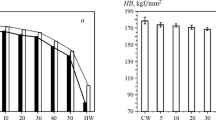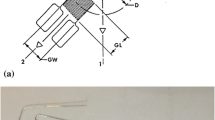Conclusions
Studies of new water-based quenchants with additions of water-soluble organic polymer (polyethylene oxide) showed that with concentration of 0.12 and 0.25% the mechanical properties and corrosion resistance of plates of alloy D16 are practically the same as after quenching in water, but there is four to five times less warping.
Similar content being viewed by others
Literature cited
E. Dublberg, SAE J.,72, No. 8 (1964).
E. G. Il'yushko and A. S. Bedarev, “Quenching of aluminum alloys in liquid nitrogen,” Metalloved. Term. Obrab. Met., No. 1, 46 (1968).
O. R. Singleton, “New quenchants for aluminum,” Aluminum (FRG)45, No. 8, 499 (1969).
Additional information
Translated from Metallovedenie i Termicheskaya Obrabotka Metallov, No. 1, pp. 48–52, January, 1978.
Rights and permissions
About this article
Cite this article
Bedarev, A.S., Konyukhov, G.P., Il'yushko, E.G. et al. Use of water-soluble polymers for quenching aluminum alloys. Met Sci Heat Treat 20, 48–52 (1978). https://doi.org/10.1007/BF00670443
Issue Date:
DOI: https://doi.org/10.1007/BF00670443




